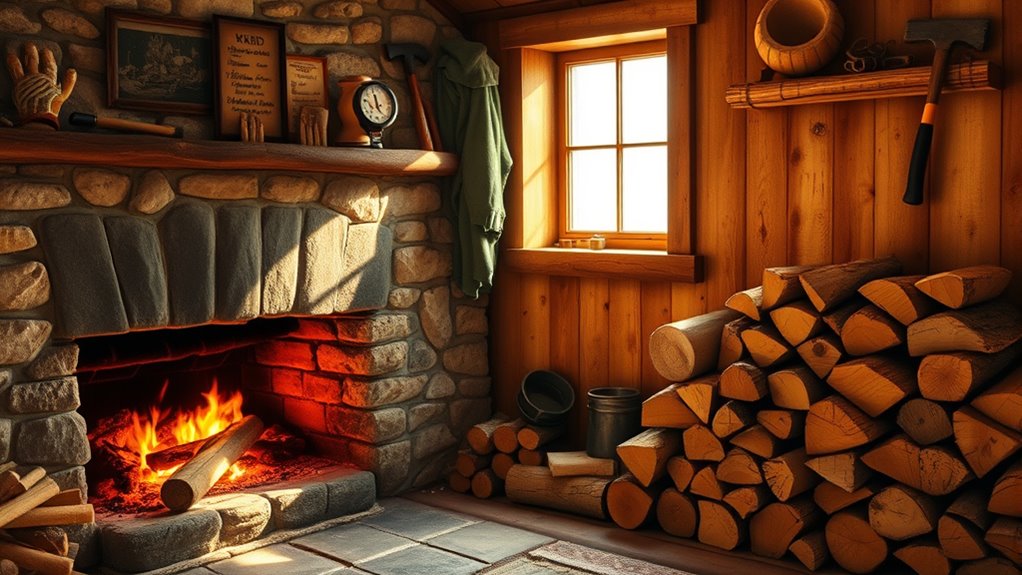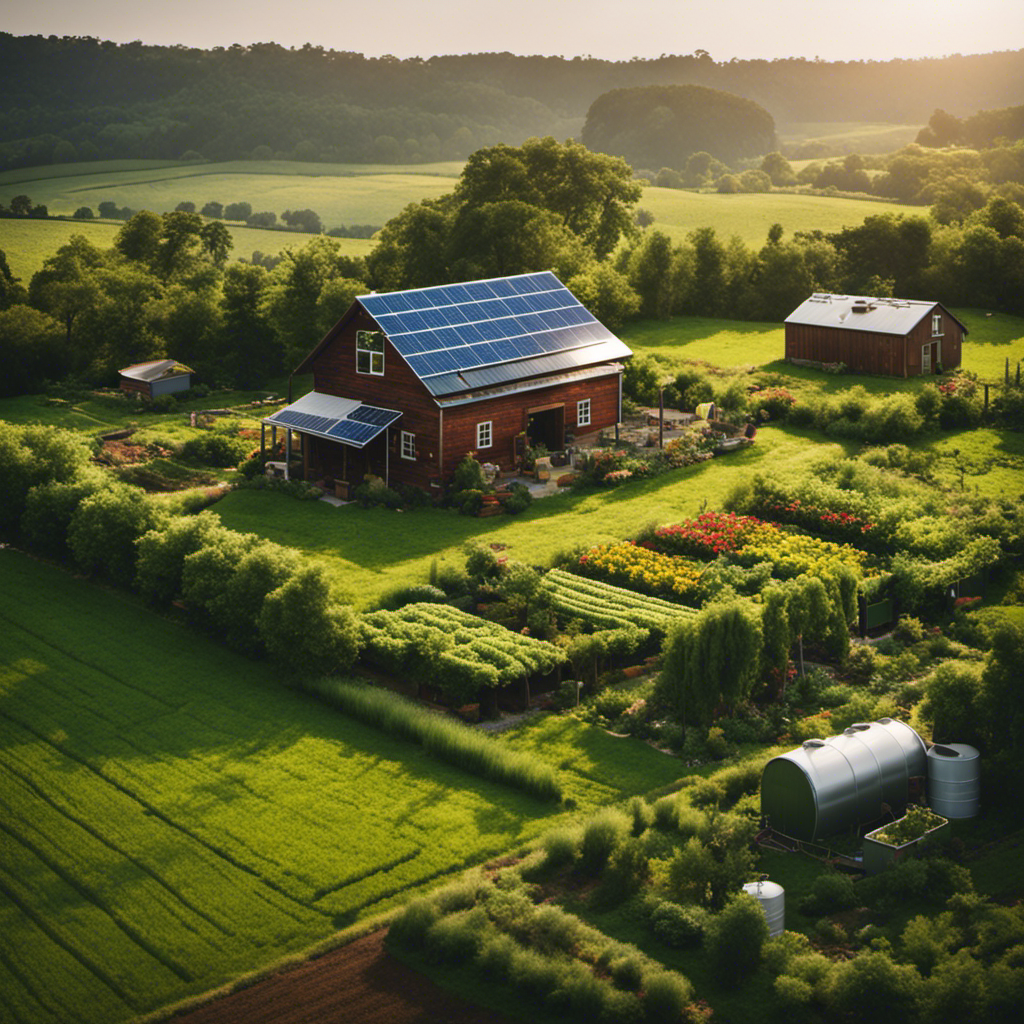To guarantee safe and efficient wood heating on your homestead, regularly inspect and clean your chimney to prevent creosote buildup and blockages. Store wood properly—off the ground, dry, and well-ventilated—to improve burning and reduce fire risks. Proper maintenance and sourcing will keep your system reliable and safe, helping you save energy and avoid costly repairs. Curious about more tips for safe wood heating? Keep exploring to learn how to optimize your setup.
Key Takeaways
- Regularly inspect and clean chimneys to prevent creosote buildup and ensure safe, efficient operation.
- Store seasoned firewood properly off the ground in a dry, ventilated area to reduce pests and moisture.
- Use dry, well-seasoned wood (6-12 months) for cleaner burns and less creosote formation.
- Keep wood sources away from your home and chimney to prevent pests, rot, and fire hazards.
- Maintain awareness of chimney safety signs like smoke escaping or indoor smells to address issues early.

Heating with wood has become a practical and reliable choice for homesteaders seeking independence and sustainability. When you choose to rely on wood heat, you take on the responsibility of proper maintenance to keep your home safe and your system efficient. One key aspect is chimney maintenance. Regularly inspecting and cleaning your chimney prevents dangerous creosote buildup, which can cause chimney fires. You should schedule annual inspections, especially before the heating season begins. During these checks, look for obstructions, creosote deposits, and any signs of damage. If you notice a strong smell of smoke inside your home or see smoke escaping from the chimney, it’s a sign you need professional cleaning or repairs. Maintaining a clean and clear chimney not only reduces fire hazards but also improves airflow, making your stove or fireplace operate more efficiently. Proper chimney maintenance is essential for ensuring safety and efficiency in your wood heat system.
Another critical element is proper wood storage. How you store your wood directly impacts safety, efficiency, and the longevity of your supply. Keep your firewood off the ground by using a sturdy rack or raising it on pallets. This prevents moisture absorption from the soil, which can lead to mold, rot, and inefficient burning. Store your wood in a well-ventilated, dry area, ideally under a roof or cover, but leave the sides open for air circulation. Properly seasoned wood—cut and stored for at least six to twelve months—burns cleaner, produces more heat, and creates less creosote. Never store wood directly against your home or near your chimney, as this can invite pests or increase fire risk. When stacking, ensure there’s enough space between logs to promote airflow and aid in drying. Regularly checking your woodpile for signs of pests or moisture helps you keep a dependable supply that burns safely and efficiently.
Finally, understanding the importance of chimney maintenance and wood storage is crucial for your safety and the sustainability of your heating system. These practices prevent dangerous situations like chimney fires and ensure your wood supply is always ready to heat your home effectively. As a homesteader, your goal is to create a self-reliant, safe environment, and paying attention to these details makes a significant difference. By keeping your chimney clean and your wood dry and properly stored, you’ll enjoy the warmth of your wood stove with peace of mind, knowing you’re minimizing hazards and maximizing efficiency. Proper maintenance not only safeguards your home but also prolongs the life of your stove and chimney, making your wood heat system a dependable and sustainable part of your homestead.
Frequently Asked Questions
How Often Should I Have My Wood Stove Professionally Inspected?
You should have your wood stove professionally inspected at least once a year. During this safety inspection, a technician will check for chimney cleaning needs, creosote buildup, and any potential hazards. Regular inspections guarantee safe operation, improve efficiency, and prevent chimney fires. If you use your stove heavily or notice issues like smoke or odors, consider scheduling inspections more frequently. Prioritize annual safety checks to keep your homestead safe and warm.
What Types of Wood Are Safest and Most Efficient for Heating?
You should choose hardwoods like oak, maple, or hickory for heating, as they’re safe and efficient. Opt for wood with low moisture content, ideally below 20%, to guarantee better heat output and less creosote buildup. Hardwoods burn longer and produce more heat, making them ideal for your stove. Always split and season your wood properly to maximize safety and efficiency, reducing the risk of chimney fires and indoor air pollution.
How Can I Prevent Chimney Fires in a Wood Stove?
Think of your chimney as a castle’s drawbridge—if it’s clogged, trouble ensues. To prevent chimney fires, you must keep it clean by regularly scheduling chimney cleaning and inspecting for creosote buildup. Install spark guards to catch embers before they ignite the surrounding area. These simple steps act as your castle’s defenses, safeguarding your home from fiery invasions and ensuring your wood stove heats safely and efficiently.
What Are the Best Practices for Storing Firewood Safely?
To store firewood safely, you should keep it in well-ventilated storage containers or racks, ideally off the ground to prevent moisture absorption. Always stack your firewood properly, allowing air circulation for seasoning and reducing mold. Cover the top to protect it from rain, but leave the sides open. Properly seasoned firewood minimizes fire hazards and ensures efficient burning, making your storage both safe and effective.
How Do I Ensure Proper Ventilation When Using Wood Heat?
Think of your home as breathing freely when you guarantee proper ventilation. You should install effective ventilation systems to promote good indoor air quality, especially when using wood heat. Keep vents clear and maintain your chimney to prevent smoke buildup. Use exhaust fans in key areas and open windows periodically to allow fresh air in. This way, you create a safe, cozy environment where your wood heat warms without compromising your home’s air quality.
Conclusion
By prioritizing safety and sourcing quality wood, you turn your homestead’s wood heat into a steady heartbeat of warmth and comfort. Think of your stove as a trusted friend—reliable when cared for properly, dangerous if neglected. With mindful practices, you’ll enjoy the cozy glow without the smoky shadows. Keep these tips close, and your homestead will shine bright with safe, sustainable warmth, like a well-tended garden blooming in the glow of a safe, steady fire.










